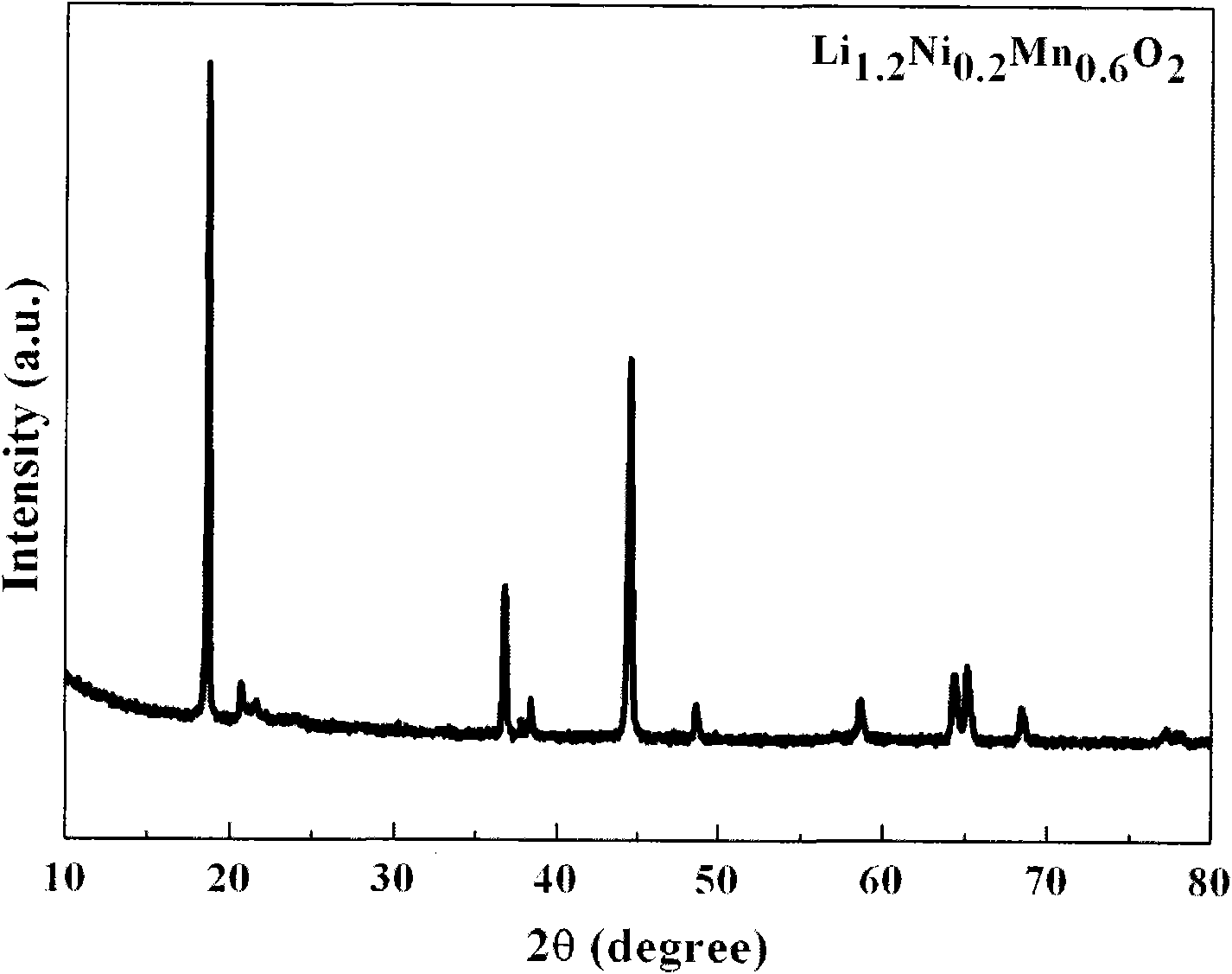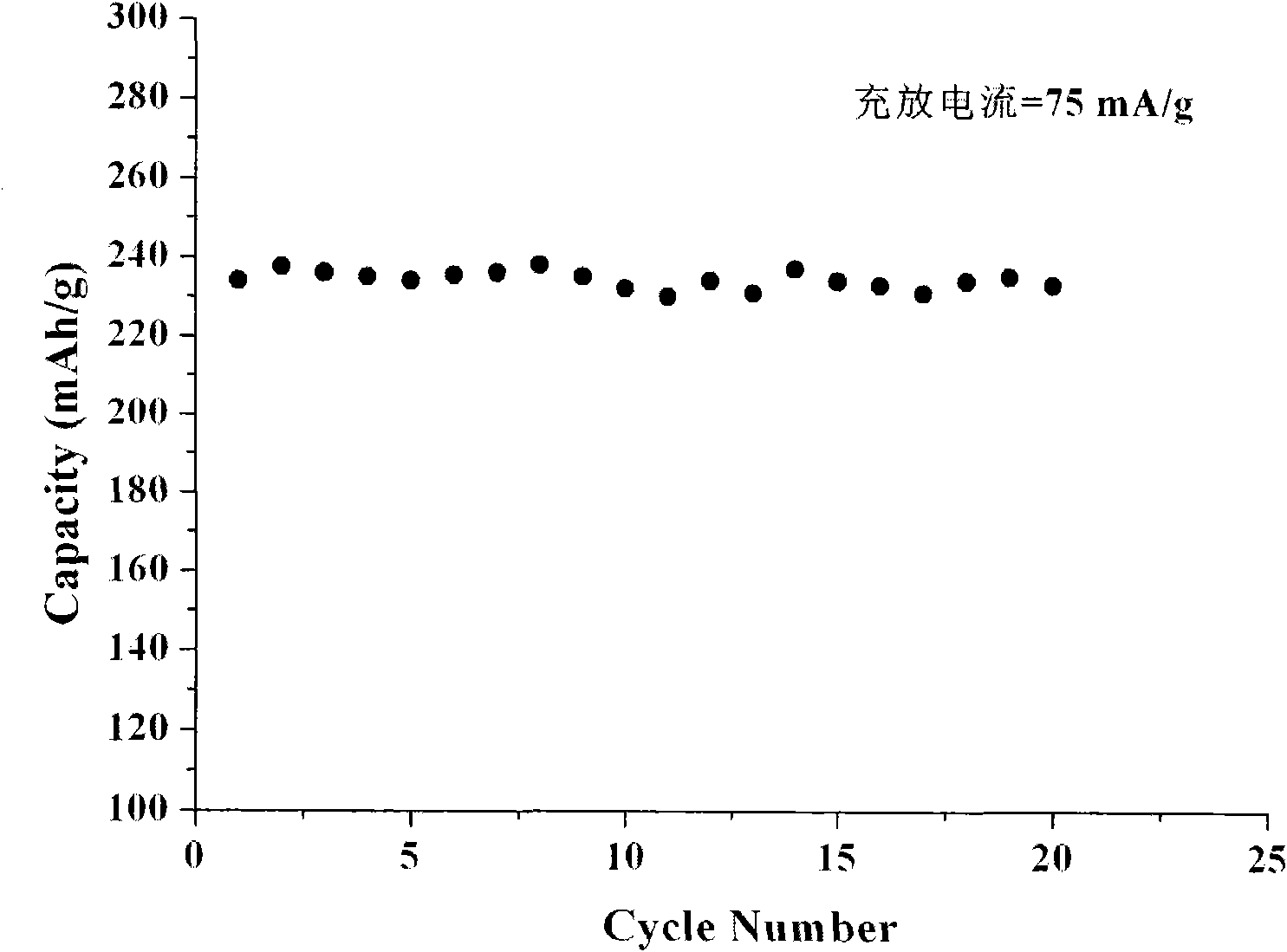Method for preparing lithium battery anode material lithium transition metal composite oxide
A composite oxide, lithium transition metal technology, applied in battery electrodes, circuits, electrical components, etc., can solve the problem of uniform and orderly arrangement of lithium and transition metal atoms, high performance, and inability to synthesize pure phase quaternary lithium transition metal composite oxides and other problems, to achieve the effect of simple preparation method, uniform particle size and low production cost
- Summary
- Abstract
- Description
- Claims
- Application Information
AI Technical Summary
Problems solved by technology
Method used
Image
Examples
Embodiment 1
[0028] Mix manganese acetate and nickel acetate at a molar ratio of 1:3, perform dry ball milling (100rpm speed, 2h ball milling time, 10:1 ball-to-material ratio), and then place the obtained powder in an air atmosphere at 500°C for roasting 5h, obtain nickel-manganese composite oxide; Then nickel-manganese composite oxide and Lithium Retard are mixed by 4: 9 mol ratio and add dehydrated alcohol and carry out wet ball milling (rotating speed is 100rpm, ball milling time 3h, ball-to-material ratio is 10: 1 ), the powder obtained by drying the slurry at 60°C after ball milling was placed in a furnace, calcined at a constant temperature of 500°C for 5 hours, and then calcined at a constant temperature of 900°C for 20 hours, and cooled rapidly with liquid nitrogen, the positive electrode material Li 1.2 Ni 0.2 mn 0.6 o 2 . The sample has no impurity phase (see attached figure 1 ), stable cycle performance (see attached figure 2 ).
Embodiment 2
[0030] Mix manganese acetate, nickel acetate, and cobalt acetate in a molar ratio of 1:1:1, perform dry ball milling (100rppm speed, 2h ball milling time, 10:1 ball-to-material ratio), and then dry ball mill once to obtain The powder was roasted at 500°C in an air atmosphere for 5 hours to obtain a nickel-manganese composite oxide; then the nickel-manganese-cobalt composite oxide was mixed with lithium carbonate in a molar ratio of 2:3 for dry ball milling (100 rpm, ball milling time 2 hours, ball The material ratio is 10:1), the powder obtained after the second dry ball milling is calcined at a constant temperature of 500°C for 5h, then calcined at a constant temperature of 900°C for 20h, and naturally cooled to room temperature with the furnace, the positive electrode material LiNi 1 / 3 mn 1 / 3 co 1 / 3 o 2 . The sample has no impurity phase (see attached image 3 ), stable cycle performance (see attached Figure 4 ).
Embodiment 3
[0032] Mix manganese acetate and nickel acetate at a molar ratio of 1:3, perform dry ball milling (100rpm speed, 2h ball milling time, 10:1 ball-to-material ratio), and then place the obtained powder in an air atmosphere at 500°C for roasting 5h, obtain nickel-manganese composite oxide; Then nickel-manganese composite oxide and lithium carbonate are mixed by 4: 3 mol ratio and add dehydrated alcohol and carry out wet ball milling (rotating speed is 100rpm, ball milling time 2h, ball-to-material ratio is 10: 1 ); the powder obtained by drying the slurry at 60°C after ball milling was placed in a furnace, calcined at a constant temperature of 500°C for 5 hours, and then calcined at a constant temperature of 900°C for 20 hours, and cooled rapidly with liquid nitrogen to obtain the positive electrode material LiNi 0.5 mn 1.5 o 4 . The sample has no impurity phase (see attached Figure 5 ), stable cycle performance (see attached Figure 6 ).
PUM
 Login to View More
Login to View More Abstract
Description
Claims
Application Information
 Login to View More
Login to View More - R&D
- Intellectual Property
- Life Sciences
- Materials
- Tech Scout
- Unparalleled Data Quality
- Higher Quality Content
- 60% Fewer Hallucinations
Browse by: Latest US Patents, China's latest patents, Technical Efficacy Thesaurus, Application Domain, Technology Topic, Popular Technical Reports.
© 2025 PatSnap. All rights reserved.Legal|Privacy policy|Modern Slavery Act Transparency Statement|Sitemap|About US| Contact US: help@patsnap.com



